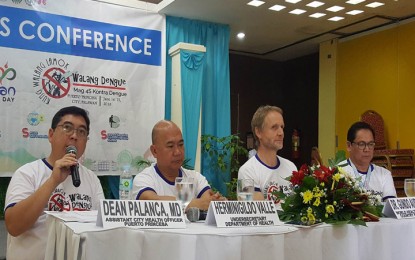
8TH ASEAN DENGUE DAY: (From left) Dr. Dean Palanca, Assistant City Health Officer of Puerto Princesa; Health Undersecretary Herminigildo Valle; Dr. Guido Aurel Weiler, WHO Country Representative; and Dr. Mario Baquilod, OIC-Director IV, DOH Regional Office IV-B during a press conference in Puerto Princesa for the commemoration of the 8th ASEAN Dengue Day on Thursday (June 14, 2018). (Photo by RTR)
PUERTO PRINCESA CITY, Palawan -- The Department of Health (DOH) has announced that Palawan’s current efforts in entomological research may have found a large larvae-eating mosquito that has the potential of destroying the immature dengue-carrying Aedis Aegypti mosquitoes.
DOH Mimaropa OIC Regional Director Mario Baquilod said on Thursday that this type of mosquito is now being bred and studied to feed on the larvae of the dengue-carriers.
“There is a mosquito they found here in their Insectarium that can feed on the larvae of other mosquitoes. It is one finding that we learned about early this morning,” Baquilod said.
The announcement was made at a press conference held here as part of the 8th ASEAN Dengue Day celebration in the province.
He said researchers working on the study of large mosquito are proud of it because it was an achievement of the satellite laboratory of the Research Institute for Tropical Medicine (RITM), which is also a training center for vector control.
Baquilod added the output of the study on the said mosquito will be seen soon upon its completion.
“This is part of the studies that RITM is conducting. Hopefully, in the future we can use this to control the spread of the dengue mosquito,” he added.
Undersecretary Herminigildo Valle, who represented Health Secretary Francisco Duque in the event, described the mosquito as looking like the “lamok kalabaw” (carabao mosquito) and subsists on the “kiti-kiti” (mosquito larvae).
“It feeds on the larvae, and this is a bigger mosquito like a carabao mosquito, and it does not bite humans, according to the experts. It’s a very promising intervention. Although it’s still being studied, eventually it seems logical that we can use this as a vector control. It’s very good work at the entomology center,” he said.
Both Baquilod and Valle, who visited the Insectarium are unable to say the name of the mosquito.
Noting the sustained presence of dengue cases in the country, the DOH has stepped up anew its awareness campaign on the “4S Strategy” to fight the mosquito-borne tropical disease.
Valle said the commemoration’s theme, “Kung Walang Lamok, Walang Dengue Mag-4S Kontra Dengue,” aims to give emphasis on vector control as a strategy to prevent and control dengue.
“Our goal to prevent dengue starts within ourselves by maintaining cleanliness in our surroundings by emptying containers of stagnant waters to eliminate breeding places of Aedes Aegypti mosquitoes,” Valle said as he read a statement by the health department.
The DOH’s 4S Kontra Dengue, he reiterated, is a useful approach to prevent cases and deaths.
The 4S are Search and Destroy mosquito breeding places, Secure Self-Protection, Seek Early Consultation and Support Fogging/Spraying only in hotspot areas where increased cases have been registered for two consecutive weeks to prevent the impending outbreak.
Since its declaration in July 2010 during the ASEAN Health Ministers Meeting in Singapore, different regions in the country have rotated as host of the ASEAN Dengue Day.
Palawan already has 581 dengue cases since January, 236 were recorded in Puerto Princesa.
From January 1 to May 26, 2018, dengue cases nationwide decreased by 7 percent or 37,959 compared to last year’s 40,993 cases for the same period. The number of deaths is 195.
The most affected group is the 10-14 years old age bracket with males comprising 52 percent of all cases.
The areas with the highest number of cases are the National Capital Region with 6,493 cases; Calabarzon, 6,296; Central Luzon, 5,997; Northern Mindanao, 2,540; Western Visayas, 2,314; and Central Visayas, 2,241. (PNA)
